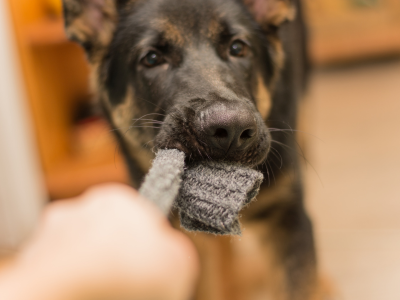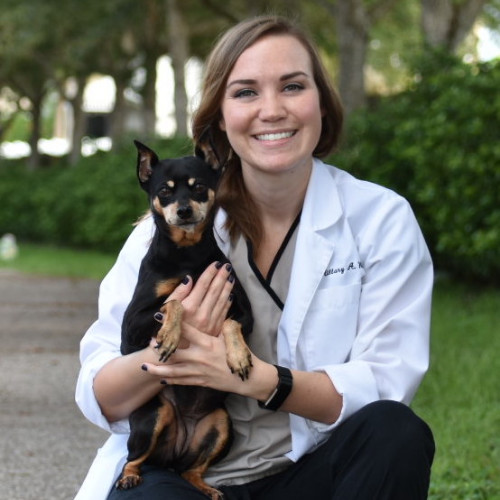Socks are common items found in every household. Among other items or hygiene products found in our bathrooms, they’re also surprisingly attractive playthings for our four-legged friends. As dog owners, it’s essential to be cautious of this seemingly harmless household item, because it can pose unexpected risks for your pet.

Why is My Dog Drawn to Dirty Socks?
Dogs are led by their noses, and dirty socks are packed with a veritable bouquet of scents. From the residue of human sweat and skin cells, the aroma can be irresistible to dogs, who perceive the world largely through their olfactory sense. It’s crucial to note that this attraction isn’t necessarily a sign of bad behavior. Instead, it’s a reminder of how differently dogs perceive the world compared to humans.
Is Eating Socks Dangerous?
The ingestion of a sock can indeed pose significant dangers for your dog. As a non-digestible item, a sock can cause a potentially life-threatening blockage in your pet’s digestive tract.
Dirty socks can also carry various bacteria, posing further risks. For instance, Staphylococcus, commonly found on socks, can cause staph infections in dogs, leading to a variety of health issues.1 Pseudomonas aeruginosa, another bacterium found on unwashed socks, can cause serious infections, especially in dogs with compromised immune systems.2
Certain strains of E. coli, also present on dirty socks, can cause digestive problems such as severe diarrhea and abdominal pain. Lastly, there’s the risk of fungal infections from species like Candida, leading to skin irritation, ear infections, and oral thrush.
How to Recognize that Your Dog Needs Help
If your dog has consumed a sock, they may exhibit a range of symptoms that suggest they’re facing a potential health issue. Being attentive to these signs can help you identify problems early and seek timely professional help.
Here are the most common symptoms:
- Loss of Appetite: A dog who has ingested a sock may lose their interest in food. This can be because the sock is causing discomfort in their digestive tract or because a blockage is preventing normal digestion.
- Vomiting: If your dog is repeatedly vomiting, this could be a sign of gastrointestinal distress. In the case of a swallowed sock, the body is attempting to expel the foreign object.
- Diarrhea: Loose or watery stools can be an indicator of a problem. The ingestion of bacteria-laden socks can upset your dog’s digestive balance, leading to diarrhea.
- Abdominal Pain: If your dog is showing signs of discomfort, such as whining, panting, or restlessness, or if their abdomen is swollen or tender to the touch, this could be a sign of a blockage or an infection.
- Lethargy: If your dog is unusually tired, reluctant to play, or moving slowly, it could be a sign that they’re feeling unwell. Lethargy can be a sign of a systemic issue caused by an obstruction or an infection.
- Changes in Behavior: Dogs can act out or become unusually quiet when they’re not feeling well. If your dog is behaving differently, such as being more aggressive, excessively licking, or isolating themselves, this could be their way of communicating discomfort.
Remember, these symptoms can also be indicative of other health issues. It’s crucial to get your dog evaluated by a veterinarian if you notice any of these signs, especially if you suspect they may have swallowed a sock.
When to Contact a Professional
If you suspect that your dog has ingested a sock and you’re noticing symptoms, it’s imperative to contact a professional immediately. Attempting to resolve the situation at home might exacerbate the problem. Veterinarians have the necessary knowledge and tools to assess the situation and provide appropriate treatment, which may involve inducing vomiting or, in severe cases, surgery.
Dogs and Socks: What to Remember
Creating a safe environment for your pet extends to everyday items like socks, which can pose serious threats if ingested. Dogs may be attracted to the scent of socks, especially dirty ones, but these items can cause dangerous blockages in their digestive tract and potentially expose them to harmful bacteria and fungi. Always keep an eye out for symptoms like loss of appetite, vomiting, or behavior changes that could indicate your dog is in distress. In case of such signs, or if you suspect your dog has swallowed a sock, don’t hesitate to contact a veterinarian. Remember, prevention is key: ensure socks and other similar items are out of your dog’s reach, keeping your pet safe and healthy.
Citations
Anti-microbial and durability characteristics of socks made of cotton and regenerated cellulosic fibers, (2018) https://www.sciencedirect.com/
Antimicrobial susceptibility of Pseudomonas aeruginosa isolates from dogs with otitis externa, (2011). https://bvajournals.onlinelibrary.wiley.com/
Frequently Asked Questions
-
Dogs are attracted to the scent of socks, especially dirty ones, due to the accumulation of human sweat and skin cells.
-
If your dog has consumed a sock, monitor for symptoms like loss of appetite, vomiting, or behavior changes. Contact a veterinarian immediately if you observe any of these signs.
-
Keep laundry, particularly socks, out of your dog’s reach. Use hampers with lids or store dirty clothes in a closed room. Regularly engage your dog with appropriate toys and playtime to satisfy their need to chew and reduce their interest in forbidden items.

